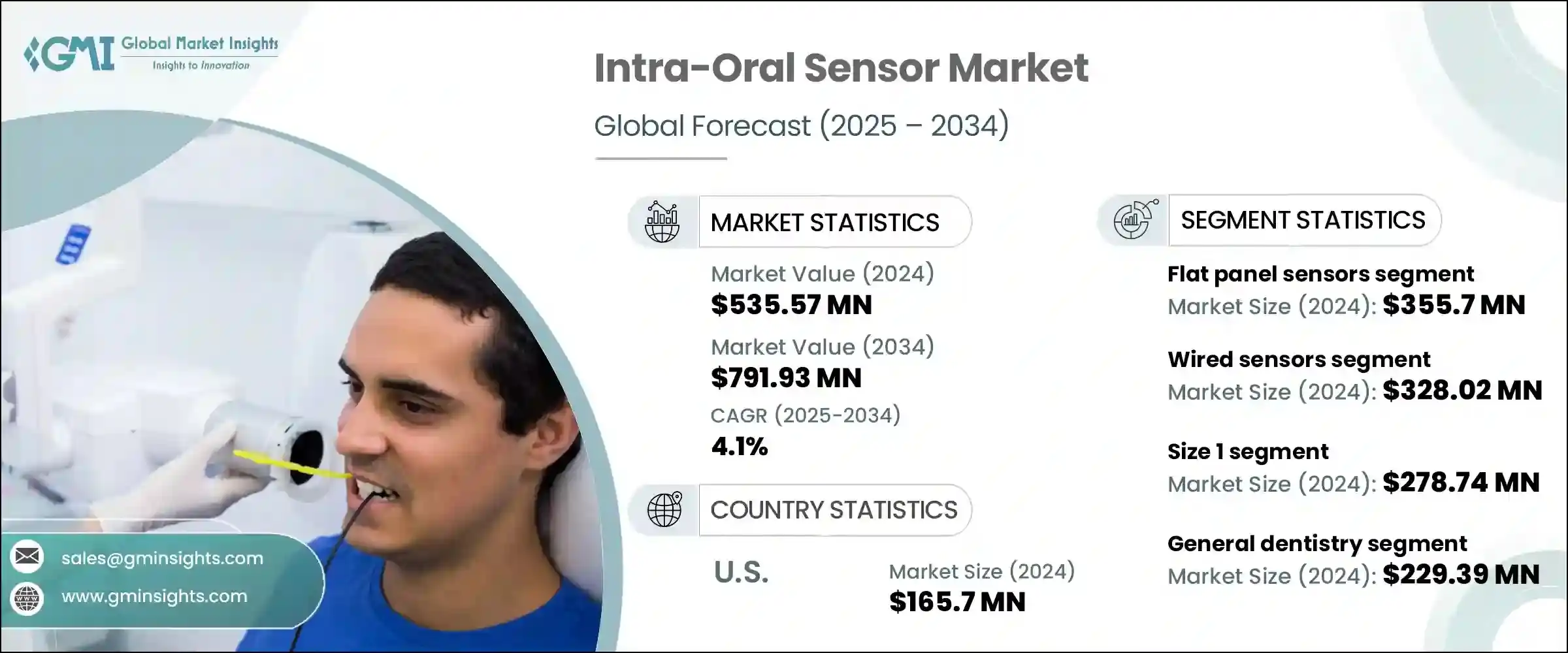
세계의 구강 센서 시장은 2024년에 5억 3,557만 달러로 평가되었고 CAGR 4.1%로 성장하여 2034년에는 7억 9,193만 달러에 이를 것으로 예측되고 있습니다.
이 시장 확대의 배경에는 치과 질환의 이환율이 증가하고 조기 및 정확한 진단에 대한 수요가 증가하고 있는 점을 들 수 있습니다. 의료종사자가 특히 노화와 관련된 질병의 발견에 대해 더 나은 진단 도구를 요구하는 가운데, 고급 영상처리 시스템은 필수적인 요소가 되었습니다.

AI를 탑재한 구강 센서의 급속한 보급은 진단 정밀도를 높이고 환자 케어 전체를 개선하면서 세계의 치과 클리닉 시장을 변화시키고 있습니다. 이러한 센서는 사람에 의한 실수를 줄임으로써 의사가 보다 빠르고 정확한 진단을 제공할 수 있도록 합니다.
| 시장 범위 | |
|---|---|
| 시작연도 | 2024 |
| 예측연도 | 2025-2034 |
| 시작금액 | 5억 3,557만 달러 |
| 예측금액 | 7억 9,193만 달러 |
| CAGR | 4.1% |
구강 센서 시장의 플랫 패널 센서 부문은 2024년에 3억 5,570만 달러를 창출했습니다. 플랫 패널 센서는 고화질 영상 출력이 가능하기 때문에 인기가 높아지고 있으며 치과 의료 환경에서 필수적인 요소가 되고 있습니다. 치과 의료종사자는 특히 치료 계획 중이나 진찰 중 진단 정밀도와 환자와의 커뮤니케이션을 개선하는 능력에 의해 이러한 센서를 점점 선호하고 있습니다. 또한, 구강 센서는 인체공학에 근거한 디자인과 실시간 영상 전달에 의해 환자와 사용자 모두에게 친화적인 제품입니다.
유선 센서 부문은 2024년에 3억 2,802만 달러의 평가액을 달성하면서 강력한 시장 포지션을 유지하고 있습니다. 이 시스템은 지속적인 전력 공급과 실시간 데이터 전송이 가능하여 처리 중 중단을 최소화합니다.
독일의 2024년 구강 센서 시장 규모는 3,027만 달러였으며, 이는 선진적인 헬스케어 시스템과 견고한 치과 의료기기 생산 기반에 지지되고 있습니다. 강력한 보험 제도와 국가 디지털화 전략에 의해 최첨단 치과 의료 기술의 채용이 늘어나고 있습니다. 기존의 이미징 툴에서 디지털 센서로의 대체가 꾸준히 증가하고 있으며, 치과 의료의 엄격한 임상 지침과 엄격한 교육 기준이 진단의 우수성과 진화하는 의료 규제에 대한 컴플라이언스를 모두 확보하기 위해 클리닉에 영상 처리 기능을 업그레이드하도록 촉구하고 있습니다.
이 시장의 주요 기업은 FONA srl, Carestream Dental LLC., Acteon Group, Dexis LLC., Genoray Co., Ltd., Dentsply Sirona Inc. 등이 있습니다. 각 제조업체는 AI와 CBCT 기술의 통합에 초점을 맞춰 진단 정확도를 높이고 신속한 이미징을 제공합니다. 또한 각사는 환자의 편의성과 진료 효율을 우선시한 소형의 무선 구강 센서를 포트폴리오에 포함하고 있습니다. 그리고 센서의 해상도를 향상시키고 방사선 피폭을 줄이기 위한 연구개발에도 투자하고 있습니다.
The Global Intra-Oral Sensor Market was valued at USD 535.57 million in 2024 and is estimated to grow at a CAGR of 4.1% to reach USD 791.93 million by 2034. This expansion is driven by a rising incidence of dental disorders and a growing demand for early and accurate diagnosis. Intra-oral sensors play an essential role in capturing high-resolution digital images of teeth and surrounding structures, enabling improved diagnostic accuracy, more precise treatment planning, and enhanced patient outcomes. As dental professionals seek better diagnostic tools-especially in detecting age-related conditions-advanced imaging systems are becoming indispensable. Technologies such as AI-integrated 3D imaging and Cone Beam Computed Tomography (CBCT) have improved image fidelity and diagnostic speed, reducing patient discomfort and streamlining dental workflows.

The rapid adoption of AI-powered intra-oral sensors is transforming dental clinics worldwide by elevating diagnostic precision and improving overall patient care. These advanced systems leverage artificial intelligence to automatically detect anomalies, streamline image analysis, and reduce human error, allowing practitioners to deliver faster and more accurate diagnoses. As AI continues to evolve, sensors equipped with machine learning algorithms can now identify early signs of cavities, gum disease, and bone loss with minimal manual input.
| Market Scope | |
|---|---|
| Start Year | 2024 |
| Forecast Year | 2025-2034 |
| Start Value | $535.57 million |
| Forecast Value | $791.93 million |
| CAGR | 4.1% |
The flat panel sensors segment in the intra-oral sensor market generated USD 355.7 million in 2024. Their rise in popularity is largely driven by high-definition image output, which allows for enhanced visualization of fine dental structures. These sensors integrate seamlessly into digital workflows, making them indispensable in modern dental environments where precision, speed, and interoperability with practice management systems are essential. Dental professionals increasingly favor these sensors due to their ability to improve diagnostic accuracy and patient communication, especially during treatment planning and consultations. Additionally, their ergonomic design and real-time image delivery make them both patient- and operator-friendly.
The wired sensors segment secured a valuation of USD 328.02 million in 2024 and continues to hold a strong market position. Known for their durability, dependable image consistency, and ease of integration into existing dental software ecosystems, wired sensors remain a top choice among practitioners who prioritize reliability over wireless flexibility. These systems operate with continuous power and real-time data transfer, minimizing disruptions during procedures. Their cost-effectiveness, minimal maintenance needs, and proven track record further reinforce their preference, especially in clinics that require budget-friendly, scalable imaging solutions.
Germany Intra-Oral Sensor Market was valued at USD 30.27 million in 2024, propelled by the nation's advanced healthcare system and robust dental equipment production base. Backed by strong insurance frameworks and national digitization strategies, the adoption of cutting-edge dental technologies continues to rise. Government policies encouraging digital health solutions have led to a steady increase in the replacement of traditional imaging tools with digital sensors. Additionally, stringent clinical guidelines and rigorous training standards in dentistry push clinics to frequently upgrade their imaging capabilities, ensuring both diagnostic excellence and compliance with evolving health regulations.
Prominent players in the market include FONA srl, Carestream Dental LLC., Acteon Group, Dexis LLC., Genoray Co., Ltd., Dentsply Sirona Inc. Manufacturers are focusing on integrating AI and CBCT technologies to offer enhanced diagnostic accuracy and faster imaging. Partnerships with dental software providers and imaging OEMs are creating comprehensive, easy-to-integrate imaging solutions. To meet growing demand, companies are expanding their product portfolios to include compact, wireless intra-oral sensors that prioritize patient comfort and clinic efficiency. They are also investing in R&D to improve sensor resolution and reduce radiation exposure. Educational initiatives and training programs for dental professionals help improve adoption rates and ensure effective utilization.